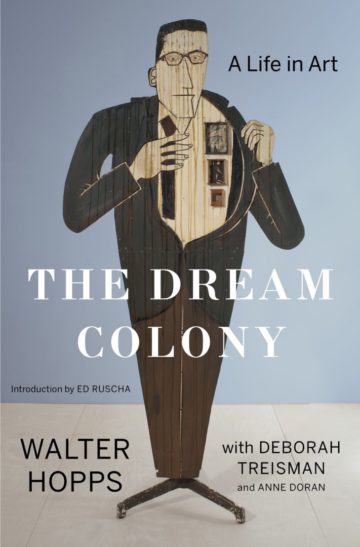
Originally published in the Marina Times San Francisco in August 2017
Many of us can’t remember a world where Andy Warhol’s soupcan paintings and Roy Lichtenstien’s ben day dots weren’t a ubiquitous part of modern art’s visual landscape. Once in a while a book comes along to remind us that the images we now take for granted were once seen for the first time. To look at something new and understand that it will someday become an accepted part of the art world requires a visionary.
The Dream Colony: A Life in Art is such a book. Curator and museum director Walter Hopps was an eccentric raconteur who was so often late that the staff at the Corcoran Gallery (where Hopps was the director in 1970 ) wore buttons which said “Walter Hopps Will Be Here in 20 Minutes”. He didn’t set out to write an autobiography in the standard way. Recorded interviews between art writer Anne Doran and Hopps make up a great deal of the narrative that shapes the book. What emerges is a portrait of a frenzied, fevered mind obsessed with art and, as Ed Ruscha remembers in the introduction, Hopps was acting as a change agent, bridging the seemingly impossible gap between artists being artists and artists having a career in the arts. Born in Los Angeles in 1932, he studied at Stanford University and UCLA before forming the legendary Ferus Gallery during the late 50’s LA scene. Along with artist Edward Keinholtz and poet Bob Alexander, the Ferus Gallery was the first west coast gallery to have a solo show of Andy Warhol’s paintings. Hopps went on to become curator and director of the Pasadena Art Museum (which later became the Norton Simon Museum) where he organized one of the first pop art exhibits called New Painting of Common Objects as well as the first retrospectives of artists like Marcel Duchamp and Kurt Schwitters.
Though the book isn’t exactly an art history lesson, Hopps personal anecdotes manage to intersect with major players in the 1960’s art world in a way that’s entertaining and readable. The anecdotes include firsthand accounts of the unhurried charm of Marcel Duchamp, the introduction of Warhol to Dennis Hopper (via Hopps, of course), the cautious introversion of Joseph Cornell, the multimedia inventions of Wallace Berman and the entrepreneurial drive that connected Hopps’ creative circle to the art buying public. These episodes capture the curator as maverick storyteller of contemporary art, and Walter Hopps brings a zany charm to the place where art meets commerce.